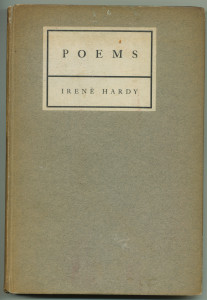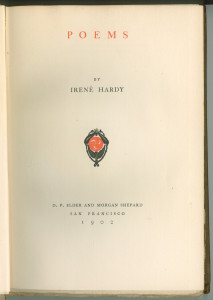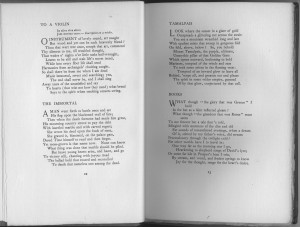
Paul Elder published a lot of poetry in his career: of the 414 titles on the checklist, at least sixty-one (15%) are poetry. While much of it is forgettable poetry, there are exceptions, such as Irene Hardy’s Poems (1902). It is likely a vanity publication, a limited edition of 300 printed by Charles A. Murdock; half of those were later lost in a fire. The binding and paper are of good quality, and the typography is typical of the period: crisp typeface but a small font, leaving generous white space around the edges of the page.
George Hamlin Fitch, literary critic for the San Francisco Chronicle, thought Hardy’s poems were among the small amount of fine verse written in California, mentioning in particular her skill with sonnets.
The author’s name is consistently printed as “Irenè Hardy”: note the odd placement of the grave accent, which in French would normally be over the first E, “Irène.” Hardy’s poem “With the Field-Lark” was the featured supplement in the June 1902 edition of Impressions Quarterly, where her name is spelled instead with an acute accent: Irené. One possibility is that Hardy eccentrically pronounced her name Irené (ee-re-NAY) and wanted her name spelled that way, but that Murdock mistakenly printed it as Irenè. (Hardy was not French; she was born in Ohio.)

Hardy’s verses may no longer be remembered, but since her death in 1922, Stanford University has held an Irene Hardy Poetry Contest, now called the “Clarence Urmy-Irene Hardy Prize for Poetry.”
Irene Hardy died in 1922. An obituary was published in The Stanford Illustrated Review:
Irene Hardy, a student at Stanford from 1892 to 1895 and a member of the English department faculty from 1894 to 1901, died June 4 at her home, 453 Melville Avenue, Palo Alto, following an attack of pneumonia. She was born in Yellow Springs, Ohio, eighty-one years ago [22 July 1841] and for the last fifteen years had been totally blind. In spite of her handicap, she continued to write, publishing verse in the “Sunset” and other periodicals. To the last she retained the admiration and devotion of her former pupils and associates, both of Stanford and the Oakland High School, where she taught for twelve years before coming to Stanford. She began teaching at 16 years of age and after taught in Antioch, Iowa, Preparatory School. In 1861, the opening year of the Civil War, she entered Antioch College, of which Horace Mann was first president. Because of failing health, she came to California in 1871 and remained here until here death. Miss Hardy was widely known as a poet. A little book of her verse [Poems] was published in 1902 in San Francisco. Half of the edition was later destroyed in a bookstore fire and the remaining volumes were taken up by students. Among the poems included in the volume are “Ole for Forefather’s Day,” “1887,” “Ariel and Caliban,” “A Wedding Day Gallop,” and “Palo Alto Hills.” Her work later appeared in “The Overland Monthly,” “Sunset” and other periodicals. She was a pioneer in the educational field in California and had a lasting influence on the teaching of composition and literature.1The Stanford Illustrated Review, Volume 23, Issue 9, June 1922, p467

- 1The Stanford Illustrated Review, Volume 23, Issue 9, June 1922, p467